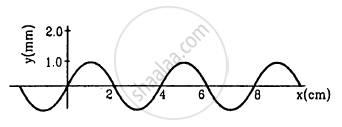Advertisements
Advertisements
Question
A tuning fork of frequency 440 Hz is attached to a long string of linear mass density 0⋅01 kg m−1 kept under a tension of 49 N. The fork produces transverse waves of amplitude 0⋅50 mm on the string. (a) Find the wave speed and the wavelength of the waves. (b) Find the maximum speed and acceleration of a particle of the string. (c) At what average rate is the tuning fork transmitting energy to the string?
Solution
Given,
Frequency of the tuning fork, f = 440 Hz
Linear mass density, m = 0.01 kgm−1
Applied tension, T = 49 N
Amplitude of the transverse wave produce by the fork = 0.50 mm
Let the wavelength of the wave be \[\lambda\]
(a) The speed of the transverse wave is given by \[\nu = \sqrt{\left( \frac{T}{m} \right)}\]
\[\Rightarrow v = \sqrt{\frac{49}{0 . 01}} = 70 m/s\]
\[Also, \]
\[\nu = \frac{f}{\lambda}\]
\[ \therefore \lambda = \frac{f}{v} = \frac{70}{440} = 16 cm\]
(b) Maximum speed (vmax) and maximum acceleration (amax):
We have:
\[y = A \sin \left( \omega t - kx \right)\]
\[\therefore \nu = \frac{dy}{dt} = A\omega \cos \left( \omega t - kx \right)\]
\[Now, \]
\[ \nu_\max = \left( \frac{dy}{dt} \right) = A\omega\]
\[ = 0 . 50 \times {10}^{- 3} \times 2\pi \times 440\]
\[ = 1 . 3816 m/s . \]
\[And, \]
\[a = \frac{d^2 y}{d t^2}\]
\[ \Rightarrow a = - A \omega^2 \sin \left( \omega t - kx \right)\]
\[ a_\max = - A \omega^2 \]
\[ = 0 . 50 \times {10}^{- 3} \times 4 \pi^2 \left( 440 \right)^2 \]
\[= 3 . 8 km/ s^2\]
(c) Average rate (p) is given by
\[p = 2 \pi^2 \nu A^2 f^2 \]
\[ = 2 \times 10 \times 0 . 01 \times 70 \times \left( 0 . 5 \times {10}^{- 3} \right)^2 \times \left( 440 \right)^2 \]
\[ = 0 . 67 W\]
APPEARS IN
RELATED QUESTIONS
A wire of density ‘ρ’ and Young’s modulus ‘Y’ is stretched between two rigid supports separated by a distance ‘L’ under tension ‘T’. Derive an expression for its frequency in fundamental mode. Hence show that `n=1/(2L)sqrt((Yl)/(rhoL))` where symbols have their usual meanings
Given below are some functions of x and t to represent the displacement (transverse or longitudinal) of an elastic wave. State which of these represent (i) a traveling wave, (ii) a stationary wave or (iii) none at all:
y = cos x sin t + cos 2x sin 2t
Explain why (or how): Bats can ascertain distances, directions, nature, and sizes of the obstacles without any “eyes”,
Explain why (or how) The shape of a pulse gets distorted during propagation in a dispersive medium.
You are walking along a seashore and a mild wind is blowing. Is the motion of air a wave motion?
A mechanical wave propagates in a medium along the X-axis. The particles of the medium
(a) must move on the X-axis
(b) must move on the Y-axis
(c) may move on the X-axis
(d) may move on the Y-axis.
A transverse wave travels along the Z-axis. The particles of the medium must move
A wave moving in a gas
Mark out the correct options.
Figure shows a plot of the transverse displacements of the particles of a string at t = 0 through which a travelling wave is passing in the positive x-direction. The wave speed is 20 cm s−1. Find (a) the amplitude, (b) the wavelength, (c) the wave number and (d) the frequency of the wave.

A vertical rod is hit at one end. What kind of wave propagates in the rod if (a) the hit is made vertically (b) the hit is made horizontally?
A transverse wave described by \[y = \left( 0 \cdot 02 m \right) \sin \left( 1 \cdot 0 m^{- 1} \right) x + \left( 30 s^{- 1} \right)t\] propagates on a stretched string having a linear mass density of \[1 \cdot 2 \times {10}^{- 4} kg m^{- 1}\] the tension in the string.
An organ pipe, open at both ends, contains
In the arrangement shown in figure , the string has a mass of 4⋅5 g. How much time will it take for a transverse disturbance produced at the floor to reach the pulley? Take g = 10 m s−2.

A heavy but uniform rope of length L is suspended from a ceiling. (a) Write the velocity of a transverse wave travelling on the string as a function of the distance from the lower end. (b) If the rope is given a sudden sideways jerk at the bottom, how long will it take for the pulse to reach the ceiling? (c) A particle is dropped from the ceiling at the instant the bottom end is given the jerk. Where will the particle meet the pulse?
A transverse wave of amplitude 0⋅50 mm and frequency 100 Hz is produced on a wire stretched to a tension of 100 N. If the wave speed is 100 m s−1, what average power is the source transmitting to the wire?
Three resonant frequencies of a string are 90, 150 and 210 Hz. (a) Find the highest possible fundamental frequency of vibration of this string. (b) Which harmonics of the fundamental are the given frequencies? (c) Which overtones are these frequencies? (d) If the length of the string is 80 cm, what would be the speed of a transverse wave on this string?
Given below are some functions of x and t to represent the displacement (transverse or longitudinal) of an elastic wave. State which of these represent (i) a traveling wave, (ii) a stationary wave or (iii) none at all:
y = 3 sin (5x – 0.5t) + 4 cos (5x – 0.5t)
